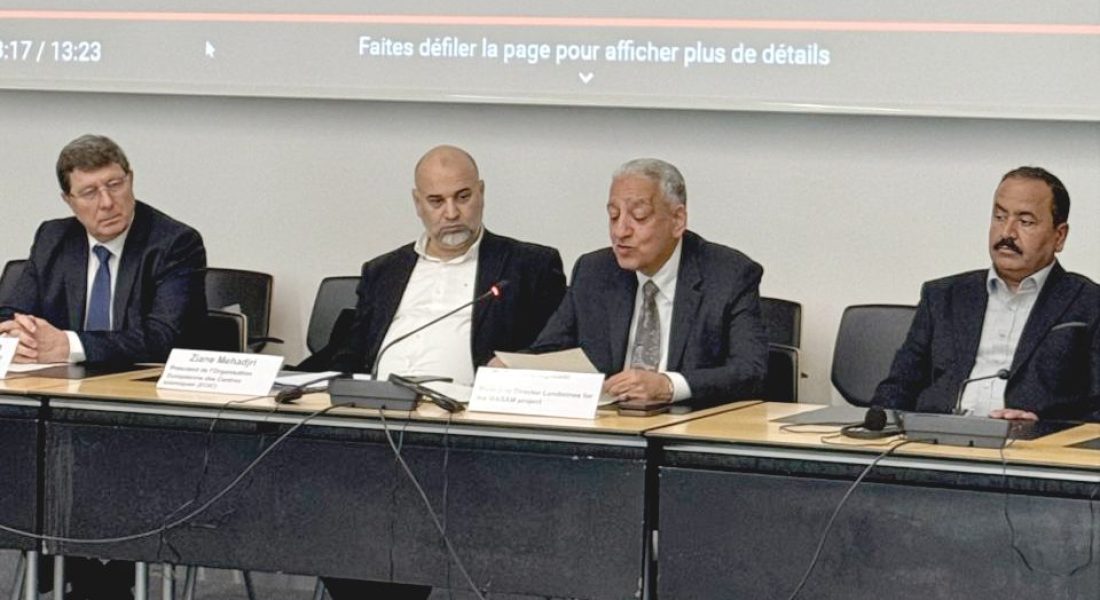Full speech delivered by Project Masam’s Managing Director Ousama Algosaibi during a meeting with the European Organisation of Islamic Centres at the United Nations international conference building in Geneva, Switzerland, on 2 May 2024.
“I am the Managing Director of Project Masam. Kindly funded by the Kingdom of Saudi Arabia via the King Salman Humanitarian Aid & Relief Centre, Masam is Yemen’s largest humanitarian mine clearance project.
“This adventure started in December 2017, when the Kingdom of Saudi Arabia signed an agreement with the Yemeni government to enhance the security measures in the region and ensure Yemen can rebuild and find stability.
“We work hand-in-hand with the Yemen Executive Mine Action Centre (YEMAC), for which we help train, supervise and monitor demining teams – as well as provide the latest equipment and training. We have grown to 583 staff including 550 working inside Yemen the majority of which are locals, and have 32 demining teams working out of our two headquarters, Aden and Marib. Over the years, our partnership with the Yemen Mine Action Centre has only strengthened, and earlier this year, our hard work and unique relation with our Yemeni colleagues was recognised by Yemen’s President Rashad Al-Alimi. In March, he awarded Project Masam and YEMAC with the Order of Bravery for our humanitarian landmine clearance efforts to clear Yemen of landmines and other remnants of war.
“Indeed, we first launched our clearance operations in June 2018 and have successfully cleared close to half a million landmines, IEDs and other remnants of war. For those interested in the detail – we have cleared 438,413 explosive devices in Yemeni liberated areas since launch – that includes 6,496 banned anti-personnel mines, 144,211 anti-tank mines, 8,023 IEDs and 279,683 unexploded ordnance.
“While these numbers are terrifying, we estimated that the Houthis have planted anywhere between 1 and 2 million mines in Yemen – and we have evidence they are still planting them in strategic areas ahead of a potential offensive. This is in spite of the Stockholm Agreement (which although it does not guarantee peace across the whole of Yemen, still included a ceasefire and an end to the hostilities. This should also include the deliberate and largely unmapped scattering of mines.
“What you need to understand about Yemen is the complexity of the work. First – we are working in an active conflict theatre. This means it is also our job to provide security to our deminers – not only in the minefield, but anywhere they may be working, travelling to or resting. There is a huge issue with IEDs in Yemen – planted by the Houthis, Al Qaeda in the Arabian Peninsula, and the Islamic State –, and moving frontlines and sporadic bouts of violence means our teams have to constantly be on alert. We work closely with local authorities and security to ensure the safety of all.
“In alignment with the global mine action sector, our responsibilities include the clearance, removal or destruction of landmines stockpile and remnants of war.
By destroying the explosive items, our EOD teams ensure they can no longer function as designed or be repurposed — this effectively protects civilian populations and helps to eradicate these deadly weapons.
“Secondly, let me talk about the minefields themselves. Here, in Yemen, we are not dealing with conventional minefields, rather we respond to reports fields of mines planted with no discernible pattern. We have mixed minefields and non-patterned anti-personnel mine fields. We have landmines and IEDs planted under school floorboards, inside families’ ovens, inside civilian cars, outside the entrance to homes, inside trees. We have rock mines and other IEDs made to resemble tree trunks, breeze-blocks, and we have evidence of IEDs using tuna or bean cans to contain the explosive content.
“Imagine yourself on this context, and let me add environment, geography and weather to the mix. Some of our teams are clearing landmines on flanks of steep, rugged mountains across most of the region between Yemen’s Coastal Plains and Highlands. In war, the rule is “He who dominates the high ground usually wins the Battle,” and the Houthi militias lay anti-tank and anti-personnel mines on their approach routes to prevent Coalition Forces to reach the high ground.
Then, we have vast expense of land on the southern and west coasts – kilometres of sand, rocks and dense bushes. In and after the rainy seasons, we also face the danger of migrated mines. We have a rule: due to the heat, dust and nature of the work, our deminers don’t work for any longer than 20 minutes before taking a break. This is not an international standard, but we train our Team Leaders to ensure this rule is applied – no matter the season or the location.
“While Masam teams do not engage with any sea mines offshore, we have been giving support to YEMAC when dealing with naval mines that have washed ashore. These mines continue to disrupt international trade, but they also impact fishing communities, who are doubly impacted by this curse: nowhere is safe, on land or in the water. Earlier this year, one of our teams was sent to investigate an empty fishing boat that was found drifting along the coast of Bab Al-Mandab and brought back to shore by villagers. Inside the boat, our team discovered Yemen’s largest ever waterborne bomb which consisted of approximately 25kg of C4 explosives and at least 50kg of TNT, as well as 25 20L petrol containers. We safely removed the components and demolished the IED.
“As in any other country plagued by landmines and IEDs, people living in Yemen continue to face the violence of these deadly devices, even after the ceasefire has been negotiated and guns have been laid. In Yemen, civilians face being displaced because of the presence of landmines, farmers lose access to their fields, farms and livelihoods. Civilians lose access to drinking water, and water sources for irrigation – this in turns means animals and crops can’t be watered or irrigated.
“Then, there is the intergenerational trauma. Landmines have been planted in Yemen for decades, but never on this scale. Our media team travels across the country to meet these families, the families of victims or those lucky enough to have survived explosions. They hear stories of young brides or mothers being left by their husbands because of stigma, we hear of children whose schools have been planted by landmines, or destroyed by them, and whose education has been halted. These are children who have dreams of becoming firefighters, teachers, lawyers and doctors. Our media team also hears of families where one of both parents has been either severely injured or killed – leaving older grandparents or uncles to become their protector and provider.
“Because of the impact on civilian populations, we carry out Explosive Ordnance Risk Education in every area in which we operate – through impromptu conversations, the distribution of posters and larger setting sessions for example in schools.
Young children are taught not to touch any foreign object from a very, very young age. We work together with health clinics, rights advocates, clerics and local chiefs to create another line of defence – if our deminers are urgently called to another area, these actors are able to take the baton, and carry out EORE themselves.
“I am telling you all this in the hope that it will give you a better understanding of the realities of mine action in Yemen. I have previously described the scale of landmine planting as “not seen since the Vietnam War”. With militias currently planting new mines, our work is set to continue to be difficult but we are determined to play our role and help free Yemen of landmines. With the help of the Kingdom of Saudi Arabia, the international community and our partners, we need to raise our voice, urgently demand the Houthis stop planting landmines and request they hand in any existing maps, coordinates or information pertaining to their minefields to ensure we can rid Yemen of landmines faster and safely.”

